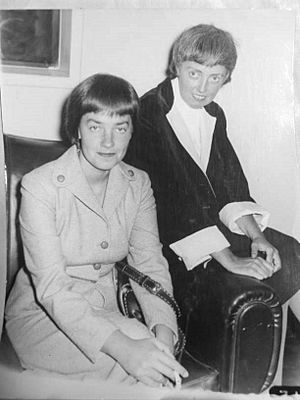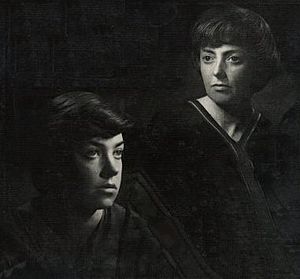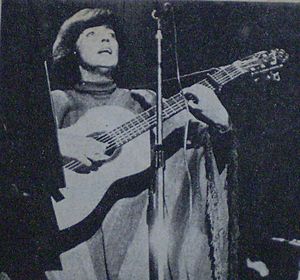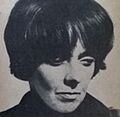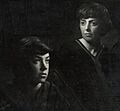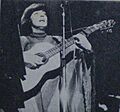Leda Valladares facts for kids
Quick facts for kids
Leda Valladares
|
|
|---|---|
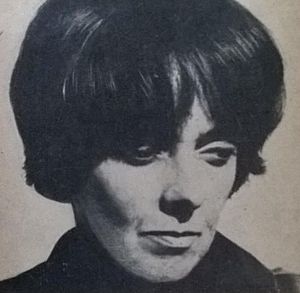
Valladares in 1971
|
|
| Born |
Leda Nery Valladares Frías
21 December 1919 San Miguel de Tucumán, Argentina
|
| Died | 13 July 2012 (aged 92) Buenos Aires, Argentina
|
| Nationality | Argentine |
| Occupation | singer, songwriter, musicologist and folklorist |
| Years active | 1940–1999 |
Leda Valladares (born December 21, 1919 – died July 13, 2012) was an amazing Argentine artist. She was a singer, songwriter, and a musicologist (someone who studies music). She was also a folklorist (someone who studies traditional culture, like folk music). Leda was born in San Miguel de Tucumán, Argentina.
Growing up, Leda was surrounded by different kinds of music. She heard classical European music and also the folk music of the native people living nearby. From a young age, she learned to play the piano. As a teenager, she started a band with her brother. They explored folk music, jazz, and blues. Leda also wrote and published poetry throughout her life. She studied at the National University of Tucumán, first English, then philosophy and education. She also spent time learning about traditional folk music directly from the people who performed it.
In the early 1950s, Leda moved to Paris and formed a music duo with María Elena Walsh. They sang traditional Argentine folk music in cafés for four years. When they returned to Argentina, folk music wasn't very popular. They kept performing and releasing albums, but their audiences were small. In 1962, Leda began a new path: documenting Argentina's folk music. Between 1960 and 1974, she created a series of albums called Mapa musical de la argentina (Musical Map of Argentina). These albums recorded and saved folk music from all over the country.
Later, Leda worked with popular musicians, including rock artists. She wanted to keep music from becoming too commercial. After Argentina's dictatorship ended in 1983, she helped preserve the country's musical heritage. Her last big project, América en Cueros (America in Leather, 1992), featured over 400 folk songs from across the Americas. For this work, UNESCO made her an "honorary member." Leda received several awards, including the Konex Award multiple times. She was also the first person to receive the National Prize for Ethnology and Folklore in 1996.
Contents
Early Life and Musical Beginnings
Leda Nery Valladares Frías was born on December 21, 1919, in San Miguel de Tucumán, Argentina. Her parents were Aurora Frías and Fermín Valladares. Her father was a writer, and both her parents loved to sing. They often had musical evenings at home.
Because Tucumán was a border region, Leda heard many types of music. Besides European classical music, she was exposed to the folk music of the native peoples in the Calchaquí Valleys. Leda started piano lessons when she was very young.
Leda and her brother, Rolando "Chivo" Valladares, became interested in jazz and blues music. As teenagers, they formed a group called Fijos. This group included other talented musicians like Adolfo Abalos and Gustavo "Cuchi" Leguizamón. They came from well-off families but used their music to challenge the usual "fancy" musical tastes of the time. In 1939, Leda started studying English at the new National University of Tucumán. After a year, she switched to philosophy and pedagogy (the study of teaching). She also loved reading European literature and was interested in new, experimental poetry.
Leda's Career Journey
Poetry and Music Studies (1940-1950)
Leda started publishing her poems in magazines in 1940. She continued to publish poetry books throughout her life. In 1941, during a festival in Cafayate, she first heard Baguala. This is a special folk music style from the Salta Province.
After hearing Baguala, Leda decided to change her studies. In 1943, she attended the Academy of Fine Arts. She learned to play the clarinet and sang in a women's group that focused on old Renaissance music. But she left after a year because she felt she couldn't express herself fully with classical music. Instead, she traveled on her own to study the traditional music of different Argentine provinces like La Rioja and Jujuy.
After finishing her philosophy and education studies in 1948, Leda traveled to Europe. On her way back, her ship stopped in Brazil. There, she saw a Macumba ceremony and noticed how the drumming rhythms were similar to the pure sound of Baguala. This made her want to learn more. She changed her plans and went to Caracas to study Afro-Venezuelan music.
When she returned to Tucumán, Leda read a book of poems by María Elena Walsh. They started writing letters to each other. In 1950, Leda began teaching in Costa Rica. In 1952, she met Walsh in Panama, and they decided to travel to Paris together. During their two months on the ship, Leda taught Walsh many folk songs and rhythms.
Working with María Elena Walsh (1952-1962)
In Paris, Leda and Walsh created a special place in their apartment for musicians to gather. They formed a duo called Leda y María (Leda and Maria). They performed traditional Argentine folk music, including bagualas, chacareras, vidalas, and zambas. They sang in famous places like the Sorbonne and in cabarets. They often performed for Spanish people who had left their home country and other Europeans. Many Argentines in France felt that focusing on folk music made their country seem less modern. But Leda and María performed for famous people like Charlie Chaplin and Pablo Picasso.
The duo started recording albums. Their first, Chants d'Argentine (Songs of Argentina), came out in 1954. A year later, they released Sous le ciel de l'Argentine (Under the Sky of Argentina). They even made a test recording for Folkways Records in 1955. An American music expert, Alan Lomax, liked their music. However, he didn't want to produce it because he felt that since they were from wealthy families, their songs weren't "authentic" folk music.
In 1956, after a big change in government in Argentina, Leda and Walsh decided to go back home. They quickly gave a talk about folk music in Tucumán. They realized that folk songs were celebrated in Paris, but not as much in Argentina. They continued to perform in smaller, more intellectual places until their musical partnership ended in 1962.
Exploring and Preserving Music (1959-1999)
In 1959, Leda received a special grant to collect folk music and map Argentina's musical traditions. She bought a recorder and traveled to many provinces, recording music. This led to a series of important albums called Mapa musical de la argentina (Musical Map of Argentina), released from 1960 to 1974. These albums helped save many traditional songs. She also worked with documentary filmmakers to create short films about Argentine folk expressions.
In 1969, Leda began performing alone, using a traditional two-sided hand drum called a caja coplera. She invited students to join her, and at one point, over 30,000 students were making music with her! Dressed in a traditional poncho, she became a symbol of a movement that wanted to keep music true to its roots, away from just being a product to sell. She worked with rock and classical musicians, bringing different styles together.
When Argentina's military government ended in 1983, Leda joined other musicians to help rebuild and develop the country's culture. They organized festivals to celebrate Argentina's musical history. Leda also worked with famous musicians like León Gieco on projects that explored music from different parts of Argentina.
Leda was honored with the Konex Award in 1984, 1994, and 2005. This is a national Argentine prize for important cultural work. Her last major work, América en Cueros (America in Leather, 1992), collected over 400 folk songs from all over North and South America. UNESCO recognized this work by making her an "honorary member." In 1996, she received the first National Prize for Ethnology and Folklore for her work mapping Argentina's music. Leda stopped performing in 1999 due to health issues.
Death and Legacy
Leda Valladares passed away on July 13, 2012, in Buenos Aires. In 2019, people across Argentina celebrated the 100th anniversary of her birth. There's even a proposal for a "National Day of Singing with a Hand Drum" to honor her work. Leda Valladares is remembered as a very important person who influenced many Argentine musicians and helped preserve Argentina's rich cultural and musical heritage.
Selected Works
Discography of Leda y María
- 1954: Chants d’Argentine
- 1955: Sous le ciel de l’Argentine [Bajo los cielos de la Argentina]
- 1957: Entre valles y quebradas, vol. 1 & 2
- 1958: Canciones del tiempo de Maricastaña
- 1959: Leda y María cantan villancicos (EP)
- 1960: Canciones de Tutú Marambá (EP)
- 1962: Canciones para mirar
- 1962: Doña Disparate y Bambuco (EP)
- 1963: Navidad para los chicos (EP)
Other Works
- 1964: El reñidero musical score for the 1962 play by Sergio De Cecco.
- 1960–1974: Mapa musical de la argentina, Melopea Records directed by Litto Nebbia (re-released in 2001 by Discos del Rojas and Melopea):
- vol. 1: Documental folklórico de la Quebrada de Humahuaca.
- vol. 2: Documental folklórico de Tucumán: Cantores de patio y de los valles.
- vol. 3: La montaña va a la escuela.
- vol. 4: Manantiales del Canto Argentina en cerros y llanos.
- vol. 5: Documental folklórico de Cuyo.
- vol. 6: Documental folklórico de Salta.
- vol. 7: Documental folklórico de Santiago del Estero.
- vol. 8: Documental folklórico de la Provincia de Buenos Aires.
- 1968: Canticuento – Seleccion de música infantil.
- 1969: Pastor de cabras with Anastasio Quiroga.
- 1971: Folklore de rancho y rascacielos with Anastasio Quiroga, Susana Lago and José Luis Castiñeira de Dios at the Teatro General San Martín.
- 1985: Igual rumbo with Margot Loyola.
- 1989: Grito en el cielo.
- 1990: Grito en el cielo II.
- 1992: América en cueros.
Images for kids
See also
 In Spanish: Leda Valladares para niños
In Spanish: Leda Valladares para niños


